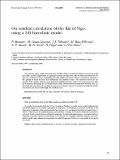Por favor, use este identificador para citar o enlazar a este item:
http://hdl.handle.net/10261/25134COMPARTIR / EXPORTAR:
 SHARE
BASE SHARE
BASE
|
|
| Visualizar otros formatos: MARC | Dublin Core | RDF | ORE | MODS | METS | DIDL | DATACITE | |

| Campo DC | Valor | Lengua/Idioma |
|---|---|---|
| dc.contributor.author | Montero, Pedro | - |
| dc.contributor.author | Gómez-Gesteira, Moncho | - |
| dc.contributor.author | Taboada, Juan José | - |
| dc.contributor.author | Ruiz-Villarreal, Manuel | - |
| dc.contributor.author | Santos, A. Miguel P. | - |
| dc.contributor.author | Neves, Ramiro | - |
| dc.contributor.author | Prego, R. | - |
| dc.contributor.author | Pérez-Villar, Vicente | - |
| dc.date.accessioned | 2010-06-09T12:37:55Z | - |
| dc.date.available | 2010-06-09T12:37:55Z | - |
| dc.date.issued | 1999 | - |
| dc.identifier.citation | Boletín del Instituto Español de Oceanografía 15(1-4): 31-38 (1999) | en_US |
| dc.identifier.issn | 0074-0195 | - |
| dc.identifier.uri | http://hdl.handle.net/10261/25134 | - |
| dc.description | 8 pages, 5 figures, 2 tables. | en_US |
| dc.description.abstract | [EN] The present paper studies circulation in the Ria of Vigo (northwest Spain) by means of a 3-D baroclinic model coupled with a Lagrangian model of dispersion. The model is examined to obtain the residual currents’ underlying periodic tidal movements. These currents are related to the quality of water because they determine the residence time. The model is forced at the mouth of the estuary with the most important tidal harmonics, and at the innermost zone with the freshwater discharge due to the presence of the Oitaven River. Results show that the area under study has a two-layered circulation, where most of water enters the estuary through the southern mouth and leaves it through the northern one. | en_US |
| dc.description.abstract | [ES] Se estudia la circulación de la ría de Vigo (noroeste de España) por medio de un modelo tridimensional baroclínico acoplado a un modelo lagrangiano de dispersión. Los resultados provenientes del modelo se utilizan para la obtención de la corriente residual que subyace a los movimientos periódicos de marea. Esta corriente se relaciona con la calidad del agua, pues determina su tiempo de residencia. El modelo es forzado en la boca de la ría a través de las constituyentes armónicas de marea más importantes y con el agua dulce introducida en la parte interior del estuario por el río Oitaven. Los resultados obtenidos muestran una circulación en doble capa, además de una entrada principal del agua por la boca sur y una salida de ésta por la boca norte. | en_US |
| dc.description.sponsorship | This work was partially supported by the Conselleria de Pesca of Xunta de Galicia, as part of the study Ordenación Integral del Espacio Marítimo Terrestre de Galicia. | en_US |
| dc.format.extent | 227408 bytes | - |
| dc.format.mimetype | application/pdf | - |
| dc.language.iso | eng | en_US |
| dc.publisher | Instituto Español de Oceanografía | en_US |
| dc.rights | openAccess | en_US |
| dc.subject | 3-D model | en_US |
| dc.subject | Ria of Vigo | en_US |
| dc.subject | Estuarine circulation | en_US |
| dc.subject | Particle tracking | en_US |
| dc.subject | Modelo tridimensional | en_US |
| dc.subject | Ría de Vigo | en_US |
| dc.subject | Circulación estuarina | en_US |
| dc.subject | Seguimiento de partículas | en_US |
| dc.title | On residual circulation of the Ria of Vigo, using a 3-D baroclinic model | en_US |
| dc.title.alternative | Sobre la circulación de la ría de Vigo usando un modelo baroclínico 3-D | en_US |
| dc.type | artículo | en_US |
| dc.description.peerreviewed | Peer reviewed | en_US |
| dc.relation.publisherversion | http://www.ieo.es/publicaciones/boletin/web-boletin99.html | en_US |
| dc.type.coar | http://purl.org/coar/resource_type/c_6501 | es_ES |
| item.openairetype | artículo | - |
| item.grantfulltext | open | - |
| item.cerifentitytype | Publications | - |
| item.openairecristype | http://purl.org/coar/resource_type/c_18cf | - |
| item.fulltext | With Fulltext | - |
| item.languageiso639-1 | en | - |
| Aparece en las colecciones: | (IIM) Artículos | |
Ficheros en este ítem:
| Fichero | Descripción | Tamaño | Formato | |
|---|---|---|---|---|
| 15_031-038.pdf | 222,08 kB | Adobe PDF |  Visualizar/Abrir |
CORE Recommender
Page view(s)
362
checked on 23-abr-2024
Download(s)
190
checked on 23-abr-2024
Google ScholarTM
Check
NOTA: Los ítems de Digital.CSIC están protegidos por copyright, con todos los derechos reservados, a menos que se indique lo contrario.
